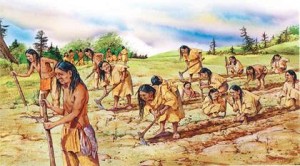<< Previous section: General Guidelines | Main Table of Contents | Next section: Chemistry >>
Table of Contents for Section A
A. Art, Photos & Cartoons
Art, Photos & Cartoons
Guidelines:
- Check the drawing’s caption. It is possible that the drawing/painting may be decorative or only minimal additional information will be needed. See Description 1, which is brief and succinct.
- If the caption is brief, or missing some key details, describe setting, subject, and action first, then include texture, orientation, and color, if relevant. See Description 2. This type of description is more widely used.
- The amount of detailed description will also depend on subject and grade level. In a college-level art history textbook, for example, all of the details, from subject to technique, are relevant.
- The description should not introduce any new terms or concepts that are not discussed or defined in the surrounding text, or that would not have been taught at that particular grade level.
Description 1:
A painting of early Native Americans farming.Description 2:
A painting depicts early Native American farmers working in a big, open field. There are many men and women, and some children working together. The women are bent over, digging long rows in the field with primitive hoes, tools with long wooden handles with flat, rectangular stone blades.This image in context:
- This image is used at the end of the section as a reading check.
- Describe general subject and setting of the painting.
- Describe the action taking place.
- The description should support the caption provided and use grade-appropriate language.
- In context, description 2 is the best fit.
Return to main table of contents | Return to top of page | Next
Guidelines:
- The length of the description will depend on subject and grade/age.
- The photo may be decorative and require no description or only a short alt text. This will be dependent upon surrounding text and whether or not a caption is included and provides sufficient information.
- Describe the location/setting and the subject. Students in lower grade levels may only need a brief description of a photo’s main idea, not necessarily much detail. See Description 1.
- Describe foreground, background, color, and directional orientation of object. A more detailed description of a photo may be appropriate for higher grade levels and certainly necessary for art and photography textbooks. See Description 2.
Description 1:
A photo of modern day downtown Louisville, Kentucky.Description 2:
A photograph of modern day downtown Louisville, Kentucky at dusk shot from across the Ohio River, with a view of a cable-stayed bridge in front of tall city buildings lit up. The river reflects a purple sky along with a freeway and tall city building lights.Image in context:
- The photo is used at the beginning of the unit to introduce the topic.
- The goal of the image is to help students get a modern picture of Kentucky but the image is decorative beyond that idea. Describe setting and main elements.
- In context, Description 1 is the best fit.
Return to main table of contents | Return to top of page | Next
3. Cartoons and Comics

Guidelines:
- Describe the picture first to give a set-up, then write out the text.
- The text may be edited if it would not make sense unless there was a long explanation.
Discription:
A comic strip is entitled Weekly Invention Labor-Saving Auto Jack. The comic shows a man sitting in a car with an elephant on the roof and a cannon on the hood. A ramp slants from the roof of the car down to a platform near the trunk. The platform is connected to a mechanical hand. The comic reads: When rear tire goes flat, pull string and fire peanut from cannon. Elephant sees peanut as it lands on platform. He walks down ramp and his weight causes hand to jack up tire! P.S. If you get a puncture in front tire, call a cab.This image in context:
- The image appears at the end of the section on simple machines.
- The text from the comic was edited. The reference steps A, B, C, etc. were not included as they distracted from the narrative of the comic.
- Credit to comic strip author, Rube Goldberg, is made in the surrounding text.
<< Previous: General Guidelines | Return to main table of contents | Return to top of page | Next: Section B (Chemistry) >>



